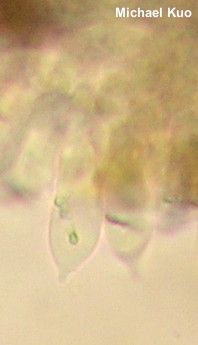| Major Groups > Gilled Mushrooms > Dark-Spored > Stropharioid Mushrooms > Stropharia melanosperma |

|
Stropharia melanosperma [ Basidiomycota > Agaricales > Strophariaceae > Stropharia. . . ] by Michael Kuo Widespread in North America but not often reported, Stropharia melanosperma grows in grassy areas and in fertilized landscaping areas. To judge from field guides and herbarium records it is more common in the southeast and in Kansas and Oklahoma than elsewhere on our continent. Distinguishing features include the white cap fringed with tooth-like veil remnants, the whitish-then-gray gills, the white ring that features a lined upper edge, and microscopic features, including fairly large spores with a slightly truncated end, and chrysocystidia (see below). Stropharia coronilla is very similar, but can be separated by its stockier stature, darker cap, and, more definitively, its smaller spores. "Stropharia melasperma" is an alternate spelling. Thanks to Joanne and Robert Solem for documenting, collecting, and preserving Stropharia melanosperma for study; their collection is deposited in The Herbarium of Michael Kuo. Description: Ecology: Saprobic, growing scattered to gregariously in grassy areas; usually found in parks, lawns, gardens, landscaping areas, and waste places; widely reported in North America. The illustrated and described collections are from Illinois. Cap: 2–5 cm; convex at first, becoming broadly bell-shaped or nearly flat; sticky when fresh; bald or very finely fibrillose; whitish overall, with a very pale, dull yellowish center—or sometimes pale straw color overall; the young margin scalloped with white, tooth-like partial veil remnants. Gills: Narrowly attached to the stem; close; short-gills frequent; whitish to very pale purplish gray at first, becoming purplish gray; edges colored like the faces. Stem: 4–8 cm long; 4–7 mm thick; equal above a slightly swollen base; bald or very finely fibrillose in places; with a high, tight ring that features a lined upper edge and which catches grayish-purplish spore dust in mature specimens; whitish; basal mycelium white. Flesh: White; unchanging when sliced. Odor: Not distinctive, or slightly foul and reminiscent of coal tar. Chemical Reactions: KOH on cap surface pale orangish pink. Spore Print: Dark purplish gray. Microscopic Features: Spores 10–13 x 6–7.5 µm; more or less ellipsoid, with one end slightly truncated by a 1–1.5 µm pore; smooth; yellow-brown in KOH; thick-walled. Basidia 4-sterigmate. Chryso-cheilocystidia abundant; 30–40 x 5–10 µm; widely fusiform, becoming rostrate with a small extension; hyaline in KOH; thin-walled; often with yellowish-refractive inclusions. Chryso-pleurocystidia scattered; similar to chryso-cheilocystidia. Lamellar trama parallel. Pileipellis a cutis; hyaline in KOH; elements REFERENCES: (Bulliard, 1793) Gillet, 1878. (Fries, 1821; Saccardo, 1887; Smith, Smith & Weber, 1979; Weber & Smith, 1985; Horn, Kay & Abel, 1003; Breitenbach & Kränzlin, 1995; Noordeloos, 1999; Ryman, 2018.) Herb. Kuo 08190201, 10030501, 06181504, 05261901. This site contains no information about the edibility or toxicity of mushrooms. |
© MushroomExpert.Com |
|
Cite this page as: Kuo, M. (2019, November). Stropharia melanosperma. Retrieved from the MushroomExpert.Com Web site: http://www.mushroomexpert.com/stropharia_melanosperma.html |






